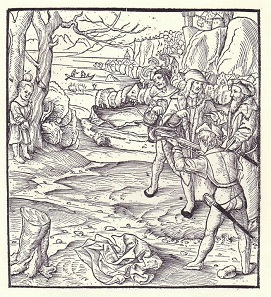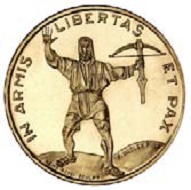by Swissmint
Due to the debasement of the Swiss franc in 1936, the Goldvreneli were practically demonetized. From then on, respective gold coins were missing in monetary transactions.
The Goldvreneli’s replacement
Therefore, the revised federal law on the monetary system from 17 December 1952 contained again full-bodied coins for 25 and 50 francs in article 3. (Full-bodied coins are fully minted coins, which means that their intrinsic value corresponds to the face value. If the gold price rises it can lead to the gold value of the coin exceeding its face value.) Dimensions and gold content of the coins are designed to correspond to the features of full-bodied karat coins (1 franc = 63/310 g fine gold).
Since the revised National Bank law from 23 December 1953 dictated the reintroduction of the gold redemption obligation (which forced the National Bank to exchange banknotes for gold coins if requested), the central bank had minted a total of 21 million gold coins between 1955 and 1959. (The coins are property of Swiss National Bank and part of the currency reserve.) Although, already in June 1954, it has been exempted from the gold redemption obligation – and still is up to this day. The coins were however minted due to monetary deliberations. The minting was part of a set of measures to fight the nascent inflation. The National Bank intended to absorb liquidity with the issuance of the new gold coins on the market.
Design of the coins
The design of a new circulation coin is mostly a difficult task, as the past has shown. This also applied to the designing of the 25- and 50-francs-coins. Previous experience – for example with the Goldvreneli – did not help a lot. The ordeal of the “new gold coins”, which still has not ended today, will be shortly explained in the following.
The competition
In the spring of 1954, 25 Swiss sculptors were invited to the competition for designing the devices. Two dozen participated. The competition conditions dictated the following among others: “The designs should correspond to the idiosyncracies of our country; the obverse should preferably depict an allegorical figure of specifically Swiss character, but not a woman’s head.” The jury consisted of five sculptors, Mister O. Bänninger, H. Hubacher, C. Reymond, R. Rossi and A. Zschokke, the representative of the Finance Administration Dr. W. Grütter, the president of the Federal Committee for Applied Arts W. von Grüningen and the numismatist and president of the Swiss Numismatic Society Dr. C. Martin. On 30 of April, they met for the first time. They did not recommend any of the submitted designs. However, four rewarded participants were invited to improve their first design or to submit a new one.
The four artists complied to the request. On 1 November 1954, the jury met again. They came to the conclusion, that this limited competition did not lead to a satisfactory result either. The prevailing opinion was that it would be more promising to commission selected artists to implement clearly defined motifs. The competition ended without success.
Tell’s apple-shot has been graphically depicted again and again since the 16th century, like in this woodcut by Hans Rudolf Manuel Deutsch in the Cosmographia by Sebastian Münster (1554). Another reference has been chosen for the new coins.
Die Drei Eidgenossen and Tell
The head of the Federal Department of Finance, Federal Council Streuli, tried to define first of all what the coins should depict with the help of leading experts in science, art and politics. They agreed on the oath for the 50-francs-coin and the crossbow or the ibex for the 25-francs-coin as symbols of freedom. A portrait of Pestalozzi was also under consideration. In order to preserve the affiliation of the coins, the reverse should be designed in the same way on both coins.
Subsequently, the Federal Department of Finance and Customs placed the order with ten artists to submit respective drafts, although the idea came up that it might rather lead to a practical result to stick to famous artwork, instead of creating new designs, as it often has been done in the past. Therefore, some of the participants had to use James Vibert’s statue Die Drei Eidgenossen for the design of the oath and the famous Wilhelm Tell by Ferdinand Hodler for the depiction of freedom.
Middle of April 1955, head of the Federal Department viewed the designs together with two sculptors who were part of the jury. They unanimously came to the conclusion that none of the submitted works were promising designs. Therefore, the Department of Finance could not choose to place an order for further processing with any of the artists invited so far.
The newly designed 25-francs-coin.
Individual orders with Rossi and Ratti
After no suitable result was achieved again, the head of the Department of Finance commissioned the Tecino sculptors Remo Rossi, Locarno, and Battista Ratti, Malvaglia to cooperate and design one obverse each and a uniform reverse for the gold coins. For that, they should simply reduce Die Drei Eidgenossen by Vibert and the depiction of Wilhelm Tell by Hodler to the size of a coin.
Remo Rossi created the designs for the obverse and Battista Ratti the ones for the reverse. The models were inspected by sculptors Hubacher und Zschokke and after that remastered. End of March 1955, the designs were presented to the entire Federal Council that approved them but still requested a few improvements.
The newly designed 50-francs-coin.
In autumn 1955, the designs were ready for minting, presented to the Federal Council, approved and patterns were presented to the audience.
The criticism
The public reacted slowly but with growing rejection to the new coins. First, the Swiss Peace Council protested against the controversial inscription “IN ARMIS LIBERTAS ET PAX” on the 25-francs-coins and Basel news later asked: “Should ‘In arms freedom and peace’ really be the quintessence of the state concept of Switzerland?” Furthermore, the approach of the Federal Council regarding the designing of the devices caused strong criticism among artists. The argument was that using a sculpture or painting in order to create small-scale coins is a violation of the existing law on designing a coin relief. Having resorted to models from the past was acting prematurely and inhibiting a valid artistic statement of the living generation. Also is was unacceptable that Rossi, who was part of the jury, then participated in the designing process. Therefore, the artists demanded that all coins should be melted down.
The Federal Council dismissed the criticism after consulting numismatists. The experts of coins explained that there have always been coins in the past designed after larger sculptural models. Additionally, a coin was not a merely artistic task like a medal, but an object of utility – a piece of money that, at the same time, was an object of value with a representative nature for the issuing country. Regarding the criticism of Rossi’s participation it has been said that after the end of the competition, the Federal Department was totally free to proceed as it wishes. Therefore, the most promising way was chosen and a clearly defined individual order was placed.
Problems with the minting
The minting of the 50- and 25-francs-gold coins started October 1955. During the inspection of the first minted coins, the responsible Central Office for Precious Metals Control noticed severe quality defects. The material was rimous and the surface partly spalled. For the time being, the mint did not react to the Central Office’s intervention and continued with the minting. Only when they demanded to stop the minting, the mint reacted. Analyses of the precious metals control showed that the gold provided by the National Bank contained perturbing contamination of lead, antimony, iron and silicon. These additives caused brittleness of the used alloy.
The mint informed the National Bank about the poor quality of the provided material and demanded material of impeccable condition for the minting of the coins. The National Bank ordered a chemical analysis of the rejected alloy by Métaux Précieux in Neuenburg. After the results of the precious metals control were confirmed, the National Bank ordered the mint to refine the existing 14,844 tons of intermediate goods and finished products (blanks and coins) at the expense of the bank. The mint’s costs for processing the contaminated gold of almost 100,000 francs were covered by Swiss National Bank. There were no mentionable problems with further mintings.
In the second chapter, you can read more about the minted coins, the artists and why the coins were not issued after all.
You can find more information about Swissmint on the website of the mint.
This week, we also present you the new 50-francs-coin with the motif of Wilhelm-Tell.
You can read all about the motif of the Goldvreneli in this acticle of the series Menschengesichter.
Another article explains the significance of the Goldvreneli as bullion coin.








